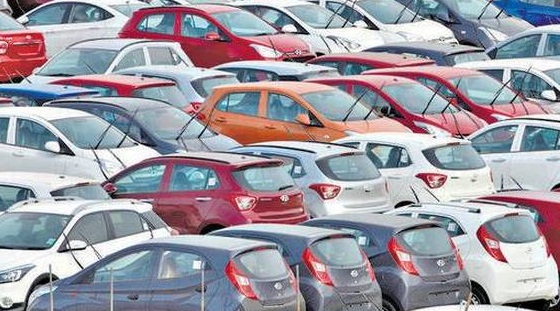
R Suryamurthy
While the Indian automobile industry is projecting continued growth in fiscal year 2025-26, following a 7.3% domestic sales increase to 19.6 million units across segments in FY24-25, a closer analysis reveals potential vulnerabilities that could derail these optimistic forecasts. Data released by the Society of Indian Automobile Manufacturers (SIAM) today, showcasing a 19.2% surge in exports alongside the domestic gains, masks underlying concerns about the sustainability of this momentum amidst a volatile global economic landscape.
FY25 witnessed record sales in key segments, yet a deeper dive into the numbers warrants caution. Passenger vehicle (PV) sales reached a historic 4.3 million units, a 2% growth that appears modest considering the high base of the previous year. Utility vehicles (UVs) continued their dominance, comprising 65% of PV sales, while exports hit a record 0.77 million units, a 14.6% jump. However, the 381,358 units sold in March 2025 and the Q4 (Jan-Mar 2025) figure of 1,162,560 units suggest a potential plateauing in growth momentum as the fiscal year concluded.
The two-wheeler segment showcased a more robust recovery with 19.6 million units sold, a 9.1% increase, and a significant 21.4% rise in exports to 4.2 million units. The growing adoption of electric two-wheelers, now exceeding 6% of the market, offers a bright spot. However, the 1,656,939 units sold in March 2025 indicate a slight dip compared to the quarterly average, warranting further scrutiny.
Three-wheelers also achieved their highest-ever sales with 7.4 lakh units, a 6.7% growth, driven by demand for last-mile mobility. Exports remained relatively modest at 3.1 lakh units, a 2.3% increase. March 2025 sales stood at 62,813 units, with Q4 reaching 178,768 units, highlighting consistent but not explosive growth.
The commercial vehicle (CV) segment presented a more concerning picture, with a slight 1.2% decline to 9.57 lakh units sold domestically. While exports surged by a healthy 23% to 0.81 lakh units, the domestic decline, despite a Q4 uptick to 272,990 units, raises questions about the strength of core economic activity that typically fuels CV demand.
The projected growth for FY26 heavily relies on the assumption of a normal monsoon, expected to boost rural demand, a crucial factor for the 19.6 million two-wheelers and entry-level PVs sold in FY25. However, this dependence exposes the industry to the vagaries of weather. Similarly, the anticipated positive impact of personal income tax reforms and RBI rate cuts on the 4.3 million PV buyers and other segments might be insufficient to counteract broader economic headwinds if global growth falters.
While touted as a driver for CV sales (which saw a slight dip to 9.57 lakh units in FY25), infrastructure spending has yet to translate into consistently strong demand, suggesting potential delays or a shift towards higher-capacity vehicles. The increasing adoption of EVs, while promising for future growth, still represents a small fraction of the total 1.97 million EV registrations in FY25, and its widespread impact on overall sales figures remains to be seen.
The most significant threat to the Indian auto industry’s FY26 growth ambitions lies in the precarious global economic environment. A potential slowdown could severely impact the 0.77 million PV and 4.2 million two-wheeler exports, among others. Geopolitical tensions and supply chain disruptions remain a persistent risk, potentially hindering the production of the 24,76,915 units produced across segments in March 2025 and impacting costs.
Domestically, the stubbornly high inflation poses a significant challenge. Despite recent RBI rate cuts, further inflationary pressures could lead to future rate hikes, increasing financing costs for the millions of potential buyers and dampening consumer sentiment. The industry’s reliance on continued government support also raises concerns about the long-term sustainability of growth without a more fundamental strengthening of consumer purchasing power.
While SIAM’s official statements highlight the positive FY25 performance, including the record 4.3 million PV and 7.4 lakh three-wheeler sales, their outlook for FY26 carries an undercurrent of caution. Shailesh Chandra, President of SIAM, emphasised that monitoring “macroeconomic factors and global geopolitics” underscores the inherent uncertainties.
Rajesh Menon, Director General of SIAM, echoed this sentiment, emphasising the strong foundation laid in FY25. “The record sales in several segments in FY2024- 25 provide a strong base for the industry to build upon in the coming fiscal year. However, maintaining this growth momentum will require careful navigation of potential challenges in the global economic landscape.”
While the Indian auto industry can celebrate the sales figures of FY25, including the highest ever numbers in key segments, the projected growth for FY26 is far from a certainty. The reliance on external factors like a favourable monsoon and a stable global economy, coupled with persistent domestic challenges like inflation, casts a shadow over the optimistic forecasts. The industry must navigate these potential headwinds carefully to sustain any meaningful growth in the coming fiscal year. The FY25 sales, while impressive in some areas, provide a baseline that will be tested by the uncertain economic realities of FY26.
